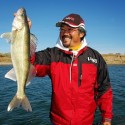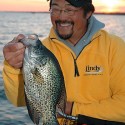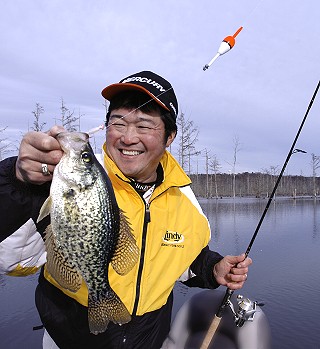| By Ted Takasaki and Scott Richardson | |||
|
Tag Archives: Ted Takasaki
Hi-Tech Sonar and its Use
By Ted Takasaki and Scott Richardson Pro fisherman Ted Takasaki hoists a monster walleye he caught with the aid of modern sonar. Technology behind ‘depthfinders’ now includes side-imaging sonar, which Takasaki uses regularly in professional tournaments. The same advantages he finds can be yours, as you seek to make good use of limited fishing time.… Continue Reading

Rigging with the Legend
By: Ted Takasaki and Scott Richardson An exclusive interview with Lindy Rig inventor Ron Lindner Ted Takasaki hoists a Lindy Rig-caught walleye. There would be no way to count the total number of walleyes caught on the famous Lindy Rig, but after reading the thoughts of inventor Ron Lindner, we hope you add to the… Continue Reading

Dancin’ for More Crappies
By Ted Takasaki and Scott Richardson Hall of Famer Ted Takasaki with a dandy springtime crappie caught using the system described in this article. Mr. Slip Bobber, Greg Bohn, outlines what you need to know to find and catch crappies as they seek warmer water in the spring. When north woods guide, Greg Bohn, fishes… Continue Reading
Icin’ Down Some Crappies!
By Ted Takasaki and Scott Richardson Whether you live near natural lakes, reservoirs, or both, use the advice in this article to find and catch winter crappies. After the fishing is over, the fish fry just might be the best part! There’s nothing like a midwinter fish fry with crappie fillets as the main… Continue Reading
Trophy Walleye Trip Planner
By Ted Takasaki and Scott Richardson Pro fisherman Ted Takasaki hoists a monster walleye against a rich October sky. From spring through winter, follow Ted’s Trophy Walleye Planner to find big fish on purpose. Catching eating-size walleyes for the skillet is fun. But, who wouldn’t want to see a 10-pound walleye in the net? … Continue Reading
Be Loud, Be Heard on the Ice
by Ted Takasaki and Scott Richardson Typical of fish caught on the Lindy Darter, even during midday, this walleye inhaled the bait with gusto. Try Jon Thelen’s aggressive approach to winter fishing and you’ll be unhooking fish rather than dealing another hand of cards. Most ice fishermen choose a serene approach, fearing they might… Continue Reading
Fall Over for Walleyes
By Ted Takasaki and Scott Richardson If you look in summer spots, your fall walleye fishing will be frustrating. But follow Hall of Famer Ted Takasaki’s transition formula and you just might score a monster like this! Though the calendar doesn’t say so yet, weather forecasters count the time around Labor Day as the start… Continue Reading
The Eyes Have It
By Ted Takasaki and Scott Richardson The rich colors of an above-water sunset belie the low light conditions fish face as they play out nature’s game of predator and prey. Read all about the art and science of color from the playbook of Hall of Fame angler Ted Takasaki, who poses here with a dandy… Continue Reading
Lindy Riggin’ Fall Trophies
By Ted Takasaki and Scott Richardson What a monster! Fall is trophy time for walleye anglers, especially if you key on the fine points presented by Hall of Famer Ted Takasaki. Here, Ted holds up a bruiser taken on a Lindy Rig baited with a big minnow, along a steep break-the same recipe you… Continue Reading

